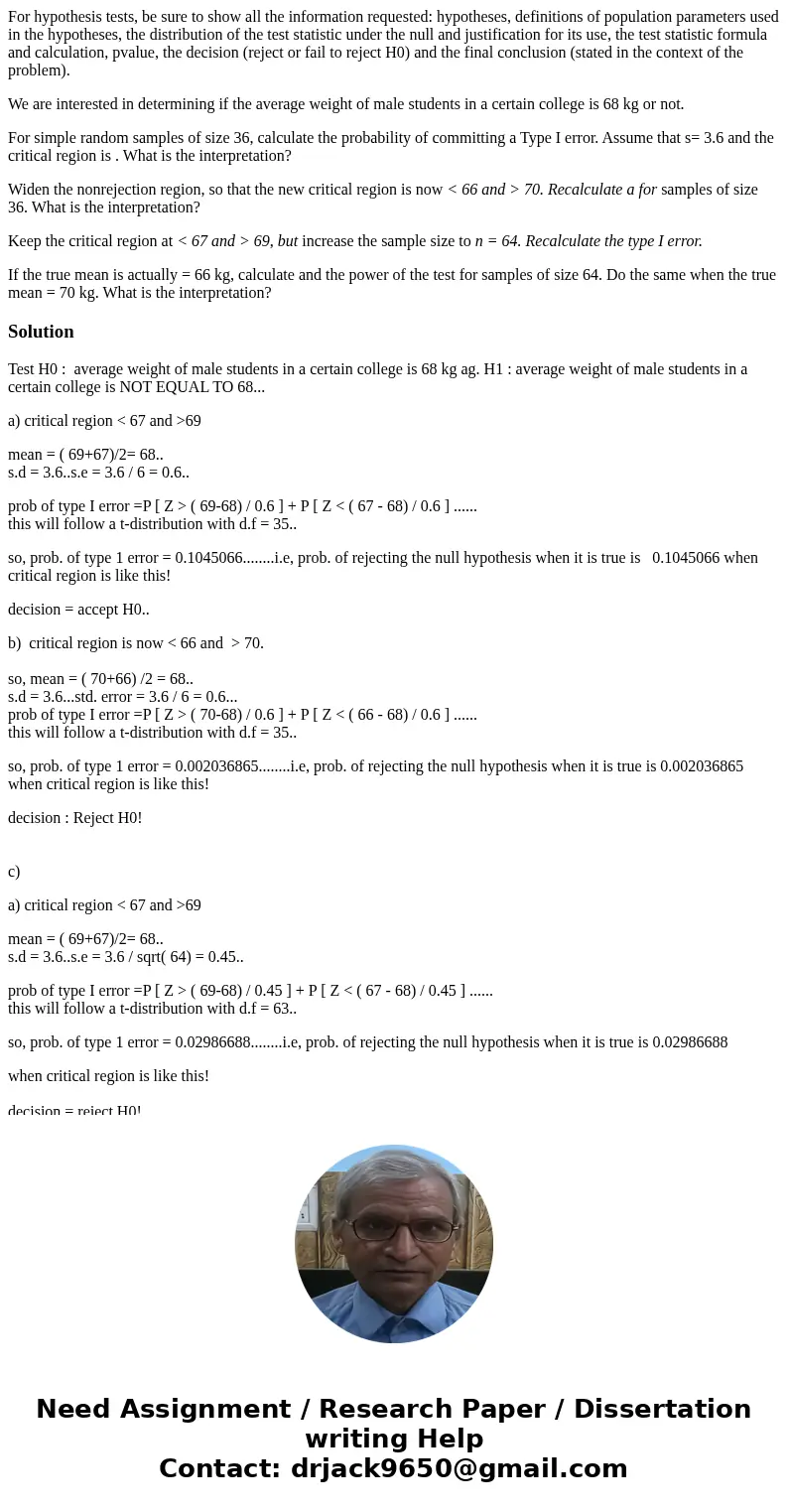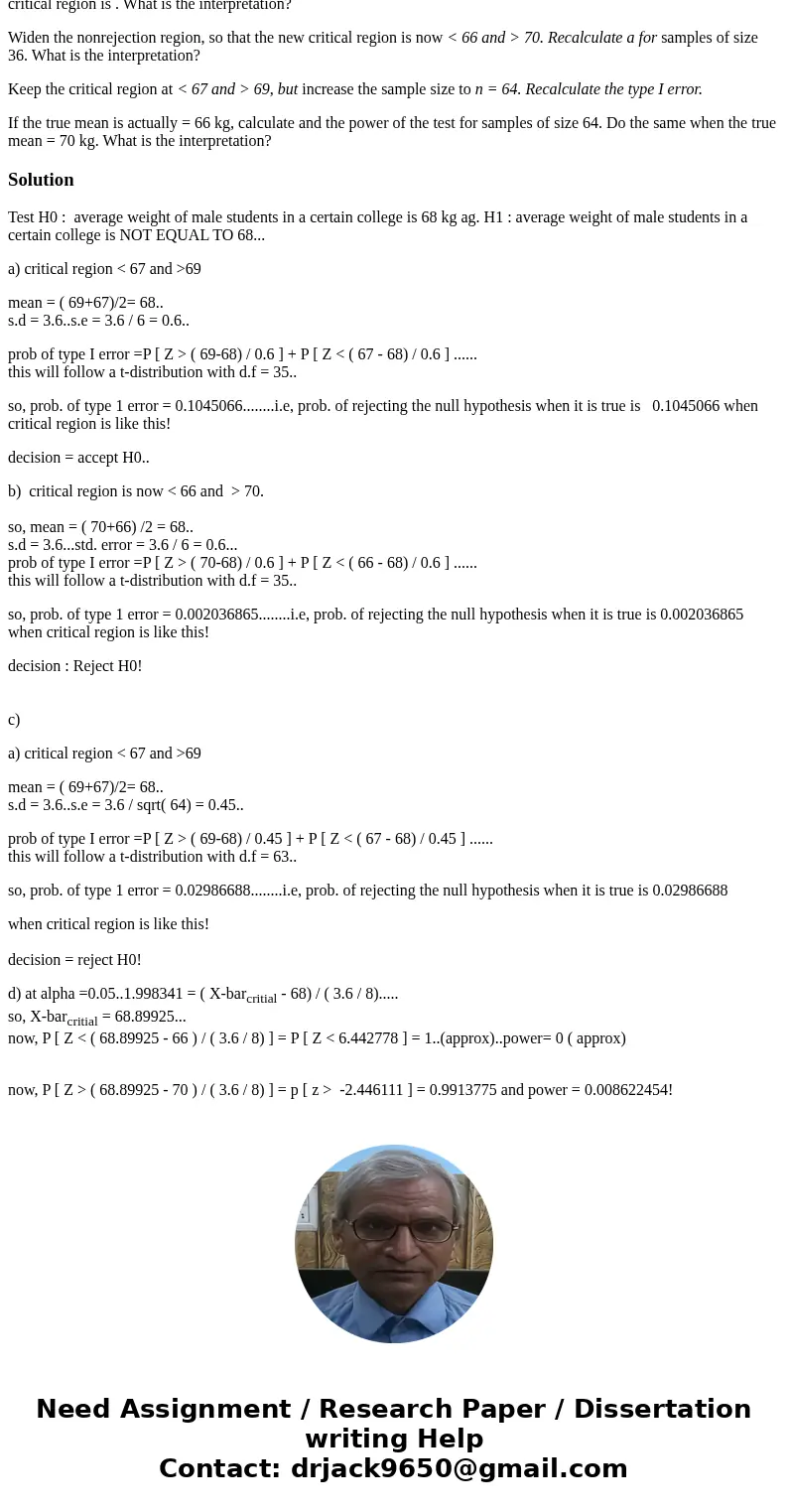For hypothesis tests be sure to show all the information req
For hypothesis tests, be sure to show all the information requested: hypotheses, definitions of population parameters used in the hypotheses, the distribution of the test statistic under the null and justification for its use, the test statistic formula and calculation, pvalue, the decision (reject or fail to reject H0) and the final conclusion (stated in the context of the problem).
We are interested in determining if the average weight of male students in a certain college is 68 kg or not.
For simple random samples of size 36, calculate the probability of committing a Type I error. Assume that s= 3.6 and the critical region is . What is the interpretation?
Widen the nonrejection region, so that the new critical region is now < 66 and > 70. Recalculate a for samples of size 36. What is the interpretation?
Keep the critical region at < 67 and > 69, but increase the sample size to n = 64. Recalculate the type I error.
If the true mean is actually = 66 kg, calculate and the power of the test for samples of size 64. Do the same when the true mean = 70 kg. What is the interpretation?
Solution
Test H0 : average weight of male students in a certain college is 68 kg ag. H1 : average weight of male students in a certain college is NOT EQUAL TO 68...
a) critical region < 67 and >69
mean = ( 69+67)/2= 68..
s.d = 3.6..s.e = 3.6 / 6 = 0.6..
prob of type I error =P [ Z > ( 69-68) / 0.6 ] + P [ Z < ( 67 - 68) / 0.6 ] ......
this will follow a t-distribution with d.f = 35..
so, prob. of type 1 error = 0.1045066........i.e, prob. of rejecting the null hypothesis when it is true is 0.1045066 when critical region is like this!
decision = accept H0..
b) critical region is now < 66 and > 70.
so, mean = ( 70+66) /2 = 68..
s.d = 3.6...std. error = 3.6 / 6 = 0.6...
prob of type I error =P [ Z > ( 70-68) / 0.6 ] + P [ Z < ( 66 - 68) / 0.6 ] ......
this will follow a t-distribution with d.f = 35..
so, prob. of type 1 error = 0.002036865........i.e, prob. of rejecting the null hypothesis when it is true is 0.002036865 when critical region is like this!
decision : Reject H0!
c)
a) critical region < 67 and >69
mean = ( 69+67)/2= 68..
s.d = 3.6..s.e = 3.6 / sqrt( 64) = 0.45..
prob of type I error =P [ Z > ( 69-68) / 0.45 ] + P [ Z < ( 67 - 68) / 0.45 ] ......
this will follow a t-distribution with d.f = 63..
so, prob. of type 1 error = 0.02986688........i.e, prob. of rejecting the null hypothesis when it is true is 0.02986688
when critical region is like this!
decision = reject H0!
d) at alpha =0.05..1.998341 = ( X-barcritial - 68) / ( 3.6 / 8).....
so, X-barcritial = 68.89925...
now, P [ Z < ( 68.89925 - 66 ) / ( 3.6 / 8) ] = P [ Z < 6.442778 ] = 1..(approx)..power= 0 ( approx)
now, P [ Z > ( 68.89925 - 70 ) / ( 3.6 / 8) ] = p [ z > -2.446111 ] = 0.9913775 and power = 0.008622454!


 Homework Sourse
Homework Sourse